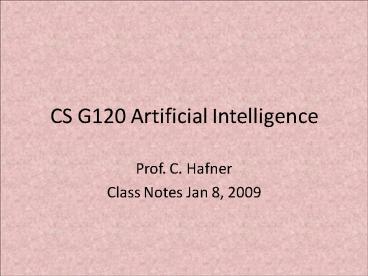CS G120 Artificial Intelligence PowerPoint PPT Presentation
1 / 22
Title: CS G120 Artificial Intelligence
1
CS G120 Artificial Intelligence
- Prof. C. Hafner
- Class Notes Jan 8, 2009
2
Goals of artificial intelligence (AI) field
- Artificial systems with humanlike ability to
understand and reason (cf. cognitive science) - Solve problems that are too large to find the
best answer algorithmically, so require
incomplete methods - Solve problems that are not well-understood
How do we judge whether we have
succeeded? getting the right answer ? the
Turing Test ? (and modified versions) usefulness
of the resulting techniques? we know it when we
see it?
3
Artificial systems with humanlike ability to
understand and reason
- Main techniques formal logic, knowledge
representation, automated deduction (employs
search algorithms) - Uses problem-solving, natural language
understanding, planning, intelligent HCI
4
Artificial systems with humanlike ability to
understand and reason (cont.)
- Main techniques evidential logics (probability,
fuzzy logic, . . .), Bayesian inference nets,
Markov models - Uses Problem solving under uncertainty, decision
support systems (expert systems)
5
Solve problems that are too large to find the
best answer algorithmically, so require
incomplete methods
- Main techniques heuristic search
dependency-directed backtracking - Uses production scheduling and other constraint
satisfaction problems game-playing - Uses a component in large-scale reasoning and
planning systems
6
Solve problems that are not well-understood
- Main techniques weighted rule-based sytems
bayesian inference nets statistical induction
and machine learning in general - Uses Finance, search engines, computational
science (discovery), data mining - Uses computer vision systems that see and
recognize objects
7
Go over syllabus
8
Framework for Intelligent Agent Design
- What can the agent do? (primitive actions)
- What can the agent know?
- Input to the program
- Symbolic input from keyboard, files, networks
- Sensing of the physical world (most often
simulated) - Memory of its history
- World knowledge
9
Types of Agents
- Reflex agent
- no state or memory
- Reacts to current input according to its program
(condition ? action rules) - Knowledgeable agent
- Reacts to current input by understanding its
meaning relative to a knowledge base - Reacts according to rules, but the condition may
be complex and require reasoning to verify
10
Types of Agents (cont.)
- Goal-based agent
- Condition ? action rules replaced by a
goal-seeking framework - One or more goals
- A set of operators that specify, for each
action - Conditions that need to be true before the action
can be performed - Effects of the action
11
General Problem Solver Example of an early
goal-based system (Herbert Simon won Nobel prize
in Economics)
Employed means-ends analysis (a pre-cursor of
backward chaining now used in many systems
Goal Transform situation A to situation B
suceed
Match A to B to find difference D
A
Subgoal Reduce D
Transform A into B
Success
none
fail
fail
Fail
Fail
Success
12
Means-ends analysis (cont)
Goal Reduce difference D between situations A
and B
A
Search for operator Q relevant to reducing D
Subgoal Apply Q to A producing A
Success
fail
fail
none
Fail
Fail
Goal Apply operator Q to A
A
A
Match A to the conditions of Q, finding
difference F
Apply Q to A
Subgoal Reduce F
Success
fail
fail
none
Fail
Fail
13
Agents and environments
- The agent function maps from percept histories to
actions - f P ? A
- The agent program runs on the physical
architecture to produce f - agent architecture program
14
Vacuum-cleaner world
- Percepts location and contents, e.g., A,Dirty
- Actions Left, Right, Suck, NoOp
15
Reflex agent
- Behavior depends only on current state (no
history) - Approach 1 Behavior expressed as a program
- Approach 2 Behavior expressed as a set of
production rules (called table-driven by RN) - Condition ? Action
- Condition ? Action
- . . .
- Condition called left-hand-side (LHS)
- Action called right-hand-side (RHS)
16
Simple Reflex Agent Vacuum Agent
Approach 1 (hard-coded behavior) if status
Dirty then return Suck else if location A then
return Right else if location B then return
Left
Called reflex because there is no world model
17
Simple reflex agents
18
Simple Reflex Agent Vacuum Agent
Approach 2 (rule-based) state ? perceive()
rule ? rule-match(state, rule
base) action ? RHS(rule) return action
Called reflex because there is no world model
19
Production rule system
- Drawbacks
- Huge RULE BASE (time consuming to build by hand)
- Inflexible (no adaptation or learning)
- What if more than one condition is satisfied?
20
Knowledgeable agents
21
Knowledge bases
- Knowledge base set of sentences in a formal
language
- Declarative approach to building an agent (or
other system) - Tell it what it needs to know
- Then it can Ask itself what to do - answers
should follow from the KB
- Agents can be viewed at the knowledge level
- i.e., what they know, regardless of how
implemented
- Or at the implementation level
- i.e., data structures in KB and algorithms that
manipulate them
22
- Q What formal language(s) can we use to
represent - Current facts about the state of the world
- General facts about how the world behaves
- General facts about the effects of actions
thatthe agent can perform - Condition ? action rules that specify how
theagent will behave - A Formal logic
- Syntax and semantics well understood
- Computational tractability known for
importantsubsets (Horn clause logic)

